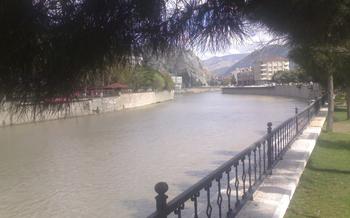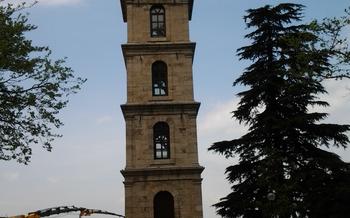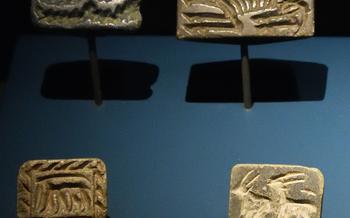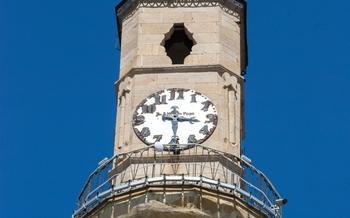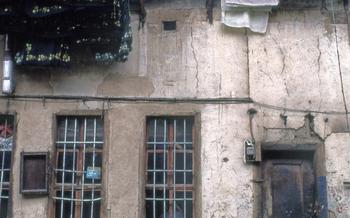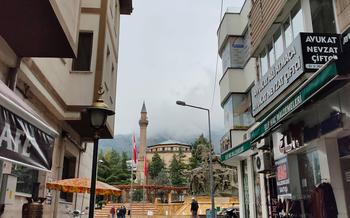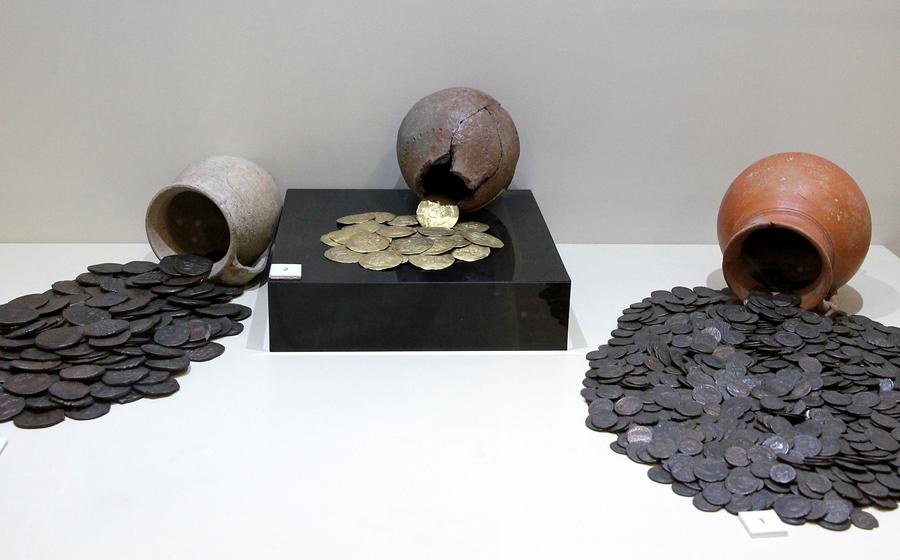
Amasya Museum
- Amasya Museum: A Journey Through History
- Unveiling the Treasures of Amasya Museum
- Embark on a Cultural Adventure
- Explore Ancient Civilizations
- Marvel at the Hellenistic Artifacts
- Discover the Secrets of the Bronze Age
- Witness the Evolution of Currency
- Admire the Regional Handicrafts
- Engage with Interactive Displays
- Guided Tours: A Deeper Dive into History
- Temporary Exhibitions: A Showcase of Diversity
- Plan Your Visit: Essential Information
- Capture the Essence of Amasya Through Photography
- Insider Tip: Discover Hidden Gems
Amasya Museum: A Journey Through History
Historical Significance: Nestled in the heart of Amasya, Turkey, the Amasya Museum stands as a testament to the region's rich and diverse history. Established in 1958, the museum has become a treasure trove of artifacts and historical relics that narrate the captivating story of Amasya's past.
Location: The Amasya Museum is conveniently located in the city center, making it easily accessible to visitors. Situated amidst the picturesque streets and historical landmarks of Amasya, the museum seamlessly blends into the city's architectural landscape.
Architecture: The museum's architectural design is a harmonious blend of traditional and modern elements. The exterior facade features intricate stonework and elegant arches, paying homage to the region's architectural heritage. Inside, the spacious galleries and well-lit displays create a welcoming and immersive environment for visitors to delve into the past.
Museum Collections: The Amasya Museum houses an impressive collection of artifacts that span various civilizations, from the ancient Hittites to the Ottoman Empire. These collections provide a comprehensive overview of the region's cultural and historical evolution, showcasing significant archaeological discoveries and curated exhibitions that bring the past to life.
Unveiling the Treasures of Amasya Museum
The Amasya Museum houses a remarkable collection of artifacts that span diverse civilizations and historical periods. These treasures provide valuable insights into the rich cultural heritage of the region and Turkey as a whole.
Artifacts from Various Civilizations:
The museum showcases artifacts from various civilizations that have flourished in the region, including the Hittites, Romans, and Ottomans. These artifacts offer a glimpse into the daily lives, customs, and artistic expressions of these ancient societies.
Archaeological Discoveries:
The museum boasts a significant collection of archaeological discoveries from the Amasya region. These discoveries, unearthed through excavations and research, have shed light on the region's past and contributed to our understanding of ancient civilizations.
Curated Exhibitions:
The museum presents curated exhibitions that highlight specific themes or periods of history. These exhibitions are designed to provide visitors with a deeper understanding of the region's cultural heritage and the significance of the artifacts on display.
Interactive Displays:
The Amasya Museum features interactive displays that enhance the visitor experience and make learning about history and culture more engaging. These displays include multimedia presentations, touch screens, and virtual reality experiences that bring the past to life.
Embark on a Cultural Adventure
Amasya Museum is not just a repository of artifacts; it's a gateway to understanding the rich cultural tapestry of Turkey. Immerse yourself in the enthralling tales of Turkish traditions, where you'll discover the essence of Anatolian heritage. Learn about the local customs and practices that have been passed down through generations, reflecting the vibrant diversity of the region.
Engage in interactive cultural workshops that provide a hands-on experience of traditional Turkish arts and crafts. Try your hand at intricate calligraphy, immerse yourself in the mesmerizing rhythms of traditional music, or witness the artistry of carpet weaving. These workshops offer a unique opportunity to connect with the local culture and create lasting memories.
As you delve deeper into the museum's exhibits, you'll uncover the region's unique heritage, shaped by the convergence of various civilizations. From ancient Anatolian settlements to the grandeur of the Ottoman Empire, Amasya has played a pivotal role in shaping Turkish culture. Through interactive displays and storytelling, the museum brings these historical narratives to life, offering a comprehensive understanding of the region's rich cultural legacy.
Explore Ancient Civilizations
Amasya Museum is a treasure trove of artifacts shedding light on the ancient civilizations that once flourished in the region. From the mighty Hittites, who left their mark on Anatolia with their impressive fortifications and rock-cut monuments, to the Romans, who brought their engineering prowess and architectural grandeur, and finally to the Ottomans, who ruled over a vast empire for centuries, Amasya has witnessed the rise and fall of some of history's most powerful civilizations.
The museum's collection boasts a wealth of artifacts that provide glimpses into the daily lives and practices of these ancient peoples. From intricately carved Hittite seals and cuneiform tablets to Roman coins and pottery, and stunning Ottoman textiles and jewelry, the museum's exhibits offer a tangible connection to the region's rich past.
Among the most fascinating artifacts are those unearthed from Amasya's ancient settlement mound, known as Harşena Höyüğü. Excavations at this site have revealed a Bronze Age civilization dating back to the 3rd millennium BC, shedding light on the origins of human habitation in the region and providing valuable insights into the development of early Anatolian cultures.
Amasya Museum stands as a testament to the enduring legacy of the ancient civilizations that once called this land home. Through its collection of artifacts and interactive displays, the museum invites visitors to embark on a journey through time, exploring the diverse cultures and traditions that have shaped the history of Amasya and the broader region.
Marvel at the Hellenistic Artifacts
Amasya Museum proudly houses a remarkable collection of Hellenistic artifacts, transporting visitors back to an era of artistic brilliance and cultural exchange. Among the highlights are exquisite sculptures and statues, each embodying the mastery of Hellenistic craftsmanship. The intricate details and lifelike expressions of these marble and bronze masterpieces offer a glimpse into the artistic prowess of the period.
Equally captivating are the intricate mosaics and pottery that adorn the museum's displays. These colorful creations depict scenes from mythology, nature, and everyday life, offering a vibrant tapestry of Hellenistic artistry. The Hellenistic influence on the region is undeniable, as evidenced by the fusion of Greek and Anatolian motifs in many of these artifacts.
The significance of these Hellenistic artifacts lies in their ability to shed light on a period of significant cultural exchange and assimilation. They showcase the interconnectedness of civilizations and the profound impact that Hellenistic culture had on the region. By studying and appreciating these artifacts, visitors gain a deeper understanding of the rich tapestry of the ancient world.
Discover the Secrets of the Bronze Age
Amasya Museum proudly houses a remarkable collection of artifacts from the Bronze Age, a period that played a pivotal role in shaping the history of Anatolia. These artifacts provide valuable insights into the daily life, practices, and beliefs of the Bronze Age civilization.
One of the highlights of the Bronze Age collection is a series of bronze tools and weapons, including swords, daggers, and axes. These artifacts showcase the advanced metalworking skills of the Bronze Age people and their reliance on bronze for both warfare and daily tasks.
Another notable exhibit is a collection of pottery and ceramics from the Bronze Age. These vessels, often decorated with intricate patterns and designs, offer a glimpse into the artistic sensibilities and craftsmanship of the period.
The museum also features a display of jewelry and ornaments from the Bronze Age, including necklaces, bracelets, and earrings. These artifacts reveal the importance of personal adornment and the role of jewelry in Bronze Age society.
Through these artifacts, visitors to the Amasya Museum can gain a deeper understanding of the Bronze Age civilization and its lasting impact on the region.
Witness the Evolution of Currency
Amasya Museum houses an extensive collection of ancient coins, providing a glimpse into the evolution of currency and monetary systems over the centuries. These coins, minted by various civilizations that ruled the region, offer valuable insights into economic history and trade practices. From the earliest forms of coinage to the sophisticated systems of the Ottoman Empire, the museum's collection showcases the diverse monetary traditions that have shaped Anatolia.
The collection includes rare and valuable coins from the Greek, Roman, Byzantine, and Islamic periods. Visitors can marvel at beautifully preserved gold and silver coins, each bearing intricate designs and inscriptions that tell stories of power, wealth, and commerce. Through these artifacts, visitors can trace the development of coinage from its humble beginnings to its role as a vital part of economic life in ancient and medieval Anatolia.
The museum's displays on coinage highlight the importance of Amasya as a trading center throughout history. The city's strategic location on the Silk Road made it a hub for merchants and traders from across the region. The variety of coins found in Amasya reflects the city's diverse trading partners and its role in facilitating commerce between East and West.
Exploring the evolution of currency at Amasya Museum offers a fascinating journey through economic history. Visitors can gain a deeper understanding of the development of money, the role of trade in shaping civilizations, and the enduring legacy of Amasya as a center of commerce and cultural exchange.
Admire the Regional Handicrafts
Amasya Museum proudly showcases the region's rich tradition of handicrafts, providing a platform for local artisans to display their exceptional skills and artistry.
-
Discover an array of traditional Turkish textiles, intricately woven with vibrant colors and captivating patterns, reflecting the region's cultural heritage.
-
Marvel at the delicate pottery, each piece meticulously crafted and adorned with unique designs, showcasing the potters' mastery and creativity.
-
Admire the intricate woodwork, from finely carved furniture to decorative objects, demonstrating the artisans' exceptional craftsmanship and attention to detail.
-
Engage with the artisans, learn about their techniques, and gain insights into the cultural significance of their craft.
-
Immerse yourself in the vibrant atmosphere of the museum's handicraft section, where the passion and dedication of local artisans come alive.
Engage with Interactive Displays
The Amasya Museum embraces modern technology to provide visitors with an immersive and engaging experience. Multimedia presentations and touch screens offer an interactive way to learn about the museum's exhibits. Visitors can explore artifacts, view historical footage, and delve deeper into the stories behind the collection.
Virtual reality experiences transport visitors to ancient times, allowing them to experience the city of Amasya during different periods of its history. Children and families can enjoy interactive activities designed to stimulate their curiosity and encourage learning. These interactive displays enhance the museum experience, making it both educational and enjoyable.
Guided Tours: A Deeper Dive into History
Enhance your museum experience by embarking on a guided tour, led by knowledgeable experts who will provide insights and explanations that bring the exhibits to life. These guided tours offer a deeper dive into the history, culture, and significance of the artifacts on display. With a guided tour, you'll gain a comprehensive understanding of the museum's collections and the stories they tell.
Customized Tours for Specific Interests:
Guided tours can be customized to cater to specific interests, whether you're fascinated by ancient civilizations, Islamic art, or regional handicrafts. The guides can tailor the tour to highlight the exhibits most relevant to your interests, ensuring a personalized and enriching experience.
Booking Options and Tour Availability:
Guided tours are available at various times throughout the day, and reservations can be made in advance to secure your spot. Check the museum's website or inquire at the information desk for booking options and tour availability.
Benefits of Taking a Guided Tour:
Participating in a guided tour offers several benefits. You'll gain insights from experts, ask questions, and receive personalized attention. Guided tours provide a structured and informative journey through the museum, ensuring you don't miss any important exhibits or details.
Temporary Exhibitions: A Showcase of Diversity
Complementing the permanent collections, the Amasya Museum periodically hosts temporary exhibitions that showcase a diverse range of themes and artifacts. These exhibitions often result from collaborations with other museums and institutions, bringing unique perspectives and valuable artifacts to Amasya.
Temporary exhibitions provide an opportunity for the museum to delve into specific topics or display newly discovered artifacts. They can focus on historical periods, artistic movements, cultural traditions, or scientific discoveries, offering visitors a fresh and dynamic experience.
By showcasing diverse themes, temporary exhibitions contribute to the museum's overall mission of promoting cultural understanding and preserving heritage. They allow visitors to explore new areas of interest, gain insights into different cultures, and appreciate the richness and complexity of human history.
Make sure to check the museum's website or inquire at the information desk for details on current and upcoming temporary exhibitions. These exhibitions often have limited run times, so plan your visit accordingly to avoid missing out on these special presentations.
Plan Your Visit: Essential Information
Before embarking on your journey through history at the Amasya Museum, it is essential to plan your visit to ensure a smooth and enriching experience. The museum's hours of operation are typically from 8:30 AM to 5:30 PM daily, providing ample time to explore its vast collection. Admission fees are nominal, making it accessible to visitors from all backgrounds.
For those with accessibility concerns, the museum is well-equipped with ramps, elevators, and accessible restrooms, allowing everyone to navigate the space comfortably. Additionally, guided tours are available in various languages, providing a deeper dive into the museum's exhibits and historical significance. These tours can be customized to suit specific interests, ensuring a personalized experience for each visitor.
To make the most of your visit, consider allocating at least two to three hours to thoroughly explore the museum's galleries and exhibits. The museum provides a map and guidebook at the entrance, helping visitors navigate the space and plan their route effectively. Lockers and storage facilities are also available for visitors to safely store their belongings while exploring the museum.
Capture the Essence of Amasya Through Photography
The Amasya Museum is a treasure trove of photographic opportunities, inviting you to capture the essence of this ancient city through your lens. While photography is generally permitted within the museum, it's crucial to adhere to the established guidelines and restrictions. Flash photography is strictly prohibited to preserve the delicate artifacts and artworks from damage.
To capture the best shots, consider utilizing natural light streaming through the museum's windows or employing a tripod for low-light conditions. Experiment with different angles and perspectives to showcase the museum's architectural details, intricate exhibits, and captivating displays.
Seek out unique vantage points within the museum to capture distinctive shots. The museum's courtyards, balconies, and upper levels offer elevated views for panoramic captures. Don't miss the opportunity to photograph the museum's exterior, blending the grandeur of its architecture with the surrounding cityscape.
Share your photographic journey on social media using the designated hashtags to connect with fellow enthusiasts and showcase the beauty of the Amasya Museum to the world. Remember, your photographs have the power to immortalize your visit, preserving cherished memories of this remarkable cultural institution.
Insider Tip: Discover Hidden Gems
Amasya Museum is a treasure trove of hidden gems waiting to be discovered. Beyond the main exhibits, there are lesser-known artifacts and secret spots that offer a unique glimpse into the region's rich history and culture.
One hidden gem is the collection of ancient coins. While the museum showcases a variety of coins, there are some rare and valuable pieces that are not on display to the general public. If you're interested in numismatics, inquire with the museum staff about the possibility of viewing these hidden treasures.
Another secret spot is the museum's rooftop terrace. While not accessible to all visitors, the terrace offers stunning panoramic views of the city and the surrounding countryside. If you're lucky enough to get access, be sure to take your camera and capture the breathtaking scenery.
Finally, don't miss the opportunity to engage with the museum's knowledgeable staff. They are a wealth of information and can provide insights into the exhibits and the history of Amasya. Ask questions, seek recommendations, and let them guide you to some of the museum's hidden treasures.
By exploring beyond the main exhibits and uncovering the museum's hidden gems, you'll gain a deeper appreciation for the rich cultural heritage of Amasya. So, take your time, wander off the beaten path, and discover the secrets that this fascinating museum holds.



